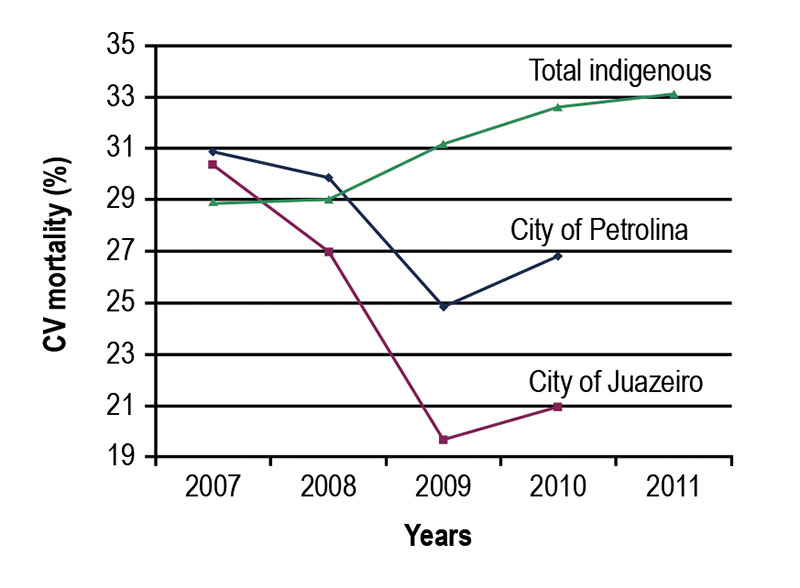Volume 110, Nº 3, March 2018
DOI: http://www.dx.doi.org/10.5935/abc.20180026
ARIGINAL ARTICLE
Urbanization is Associated with Increased Trends in Cardiovascular Mortality Among Indigenous Populations: the PAI Study
Anderson da Costa Armstrong
Ana Marice Teixeira Ladeia
Juracy Marques
Dinani Matoso Fialho de Oliveira Armstrong
Antonio Marconi Leandro da Silva
Jeová Cordeiro de Morais Junior
Aldina Barral
Luis Claudio Lemos Correia
Manoel Barral-Netto
João A. C. Lima
Dr. Anderson da Costa Armstrong

Figure 2 – Cardiovascular mortality (≥ 30 y/o) in indigenous and urban populations in the Sao Francisco Valley (Northeast Brazil). Total indigenous refers to total deaths among indigenous populations in the Sao Francisco Valley, Northeast Brazil.
Abstract
Background: The cardiovascular risk burden among diverse indigenous populations is not totally known and may be influenced by lifestyle changes related to the urbanization process.
Objectives: To investigate the cardiovascular (CV) mortality profile of indigenous populations during a rapid urbanization process largely influenced by governmental infrastructure interventions in Northeast Brazil.
Methods: We assessed the mortality of indigenous populations (≥ 30 y/o) from 2007 to 2011 in Northeast Brazil (Bahia and Pernambuco states). Cardiovascular mortality was considered if the cause of death was in the ICD-10 CV disease group or if registered as sudden death. The indigenous populations were then divided into two groups according to the degree of urbanization based on anthropological criteria:9, 10 Group 1 - less urbanized tribes (Funi-ô, Pankararu, Kiriri, and Pankararé); and Group 2 - more urbanized tribes (Tuxá, Truká, and Tumbalalá). Mortality rates of highly urbanized cities (Petrolina and Juazeiro) in the proximity of indigenous areas were also evaluated. The analysis explored trends in the percentage of CV mortality for each studied population. Statistical significance was established for p value < 0.05.
Results: There were 1,333 indigenous deaths in tribes of Bahia and Pernambuco (2007-2011): 281 in Group 1 (1.8% of the 2012 group population) and 73 in Group 2 (3.7% of the 2012 group population), CV mortality of 24% and 37%, respectively (p = 0.02). In 2007-2009, there were 133 deaths in Group 1 and 44 in Group 2, CV mortality of 23% and 34%, respectively. In 2009-2010, there were 148 deaths in Group 1 and 29 in Group 2, CV mortality of 25% and 41%, respectively.
Conclusions: Urbanization appears to influence increases in CV mortality of indigenous peoples living in traditional tribes. Lifestyle and environmental changes due to urbanization added to suboptimal health care may increase CV risk in this population. (Arq Bras Cardiol. 2018; 110(3):240-245)
Keywords: Indigenous Population; Cardiovascular Diseases / mortality; Urbanization / trends; Social Change.















